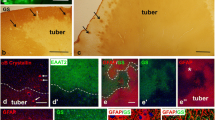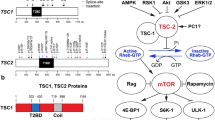Abstract
CNS lesions of tuberous sclerosis complex (TSC) are due to a developmental disorder of neurogenesis and neuronal migration. MRI studies provide excellent in vivo demonstration of the various pathologic lesions. Symptoms of cortical tubers may include seizures, mental retardation, learning disabilities, and abnormal behavior. Seizures have a focal or multifocal origin, this clinical feature depending on the localization of the cortical tubers. Epilepsy associated with TSC is often intractable, but seizure control has benefited from the introduction of the new antiepileptic drugs. Carefully selected drug-resistant patients can be assessed with intensive monitoring as candidates for surgical removal of epileptogenic lesions. The success of epilepsy surgery is predicated on the clear identification of epileptogenic foci.
Similar content being viewed by others
References
Aicardi J (1995) European experience with use of vigabatrin as first-line monotherapy in infantile spasms (abstract). Epilepsia 36:S102
Bebin EM, Kelly PJ, Gomez MR (1993) Surgical treatment for epilepsy in cerebral tuberous sclerosis. Epilepsia 34:651–657
Bruni O, Cortesi F, Giannotti F, Curatolo P (1995) Sleep disorders in tuberous sclerosis: a polysomnographic study. Brain Dev 17:52–56
Bye AM, Matheson JM, Tobias VH, Mackenzie RA (1989) Selective epilepsy surgery in tuberous sclerosis. Aust Pediatr J 25:243–245
Carbonara C, Longa L, Grosso E, Borrone C, Garre MG, Brisigotti M, Migone N (1994) 9q34 loss of heterozygosity in a tuberous sclerosis astrocytoma suggests a growth suppressor-like activity also for the TSC1 gene. Hum Mol Genet 3:1829–1831
Chiron C, Raynaud G, Cusmai R, Dulac O, Plouin P (1990) Morphological functional study in tuberous sclerosis: brain MRI/SPECT correlations (abstract). Epilepsia 31:613
Curatolo P (1994) Vigabatrin for refractory partial seizures in children with tuberous sclerosis. Neuropediatrics 25:55
Curatolo P, Cusmai R (1987) Autism and infantile spasms in children with tuberous sclerosis. Dev Med Child Neurol 29:550–551
Curatolo P, Cusmai R (1988) MRI in Bourneville disease: relationships with EEG findings. Neurophysiol Clin 18:149–157
Curatolo P, Cusmai R, Cortesi F, Jambaqué I, Chiron C, Dulac O (1991) Neurologic and psychiatric aspects of tuberous sclerosis. Ann NY Acad Sci 615:8–16
Curatolo P, Seri S, Cerquiglini A (1993) Topographic spike mapping of EEG in tuberous sclerosis (abstract). Neuropediatrics 24:178
Cusmai R, Chiron C, Curatolo P, Dulac O, Tran Dinh S (1990) Topographic comparative study of MRI and EEG in 34 children with tuberous sclerosis. Epilepsia 31:747–755
Erba G, Duchowny M (1990) Partial epilepsy and tuberous sclerosis: indications for surgery in disseminated disease. J Epilepsy 3:315–319
European Chromosome 16 Tuberous Sclerosis Consortium (1993) Identification and characterization of the tuberous sclerosis gene on chromosome 16. Cell 75:1–11
Fryer AE, Connor JM, Povey S, Yates JRW, Chalmers A, Osborne JP (1987) Evidence that the gene for tuberous sclerosis is on chromosome 9. Lancet I:659–661
Gastaut H, Zifkin B, Magaudda A, Mariani E (1987) Symptomatic partial epilepsies with secondary bilateral synchrony: differentiation from symptomatic generalized epilepsies of the Lennox-Gastaut type. In: Wieser HG, Elger CE (eds) Presurgical evaluation of epilepsies. Springer, Berlin Heidelberg New York, pp 308–316
Gillberg IC, Gillberg C, Ahlsen G (1994) Autistic behaviour and attention deficits in tuberous sclerosis: a population-based study. Dev Med Child Neurol 36:50–56
Gomez MR (1988) Neurologic and psychiatric features. In: Gomez MR (ed) Tuberous sclerosis. Raven Press, New York, pp 21–36
Gomez MR (1991) Phenotypes of the tuberous sclerosis complex with a revision on diagnostic criteria. Ann NY Acad Sci 615:1–7
Hirose T, Scheithauer BW, Lopes MBS (1995) Tuber and subependymal giant cell astrocytoma associated with tuberous sclerosis: an immunohistochemical, ultrastructural, and immunoelectron microscopic study. Acta Neuropathol 90:387–399
Hunt A, Stores G (1994) Sleep disorders and epilepsy in children with tuberous sclerosis: a questionnaire based study. Dev Med Child Neurol 36:108–115
Huttenlocher PR, Wollman RL (1991) Cellular neuropathology of tuberous sclerosis. Ann NY Acad Sci 615:140–148
Jan JE, Espezel H, Appleton RE (1994) The treatment of sleep disorders with melatonin. Dev Med Child Neurol 36:97–107
Kandt RS, Haines JL, Smith M (1992) Linkage of an important gene locus for tuberous sclerosis to a chromosome 16 marker for polycystic kidney disease. Nat Genet 2:37–41
Nixon JR, Miller GM, Gomez MR (1989) Cerebral tuberous sclerosis: postmortem MRI and pathology anatomy. Mayo Clin Proc 64:305–3111
Osborne JP, Fryer A, Webb D (1991) Epidemiology of tuberous sclerosis. Ann NY Acad Sci 615:125–127
Povey S, Burley MW, Attwood J (1994) Two loci for tuberous sclerosis: one on 9q34 and one on 16p13. Ann Hum Genet 58:107–127
Roach ES, Smith M, Huttenlocher P, Bhat M, Alcorn D, Hawley L (1992) Report of the diagnostic criteria comittee of the National Tuberous Sclerosis Association. J Child Neurol 7:221–224
Sampson JR, Harris PC (1994) The molecular genetics of tuberous sclerosis. Hum Mol Genet 3:1477–1480
Seri S, Cerquiglini A, Cusmai R, Curatolo P (1991) Tuberous sclerosis: relationship between topographic mapping of EEG, VEPs and MRI findings. Neurophysiol Clin 21:161–172
Shepherd CW, Scheithauer BW, Gomez MR, Altermatt HJ, Katzmann JA (1991) Subependymal giant cell astrocytoma: a clinical, pathologic, and flow cytometric study. Neurosurgery 38:864–868
Shepherd CW, Houser OW, Gomez MR (1995) MR findings in tuberous slcerosis complex and correlation with seizure development and mental impairment. AJNR Am J Neuroradiol 16:149–155
Szelies B, Herholz K, Heiss D (1983) Hypometabolic cortical lesions in tuberous sclerosis with epilepsy: demonstration by PET. J Comput Assist Tomogr 7:946–953
Takanashi J, Sugita K, Fujii K, Niimi H (1995) MR evaluation of tuberous sclerosis: increased sensitivity with fluid-attenuated inversion recovery and relation to severity of seizures and mental retardation. AJNR Am J Neuroradiol 16:1923–1928
Author information
Authors and Affiliations
Rights and permissions
About this article
Cite this article
Curatolo, P. Neurological manifestations of tuberous sclerosis complex. Child's Nerv Syst 12, 515–521 (1996). https://doi.org/10.1007/BF00261603
Received:
Issue Date:
DOI: https://doi.org/10.1007/BF00261603




